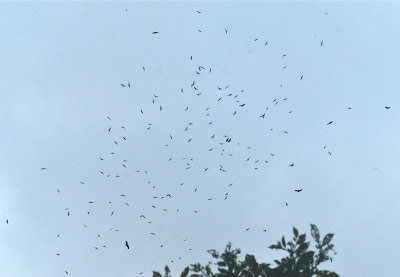In my last post, I wrote about the impressive diurnal migration of hawks and vultures over Panama City in october... but october is also the peak of the migration of many other birds, including many song birds (passerines), and the Ancon Hill is also an excellent site to watch them as well.
Sometimes, it is not clear if you are watching a migrant or a resident bird... for example, I know that the Zone-tailed Hawks nest in Panama, but definitively I see them around more often during the migration season, like the one pictured above at the Ancon Hill. Other times, it is obvious you are seeing resident birds... like the Keel-billed Toucan... who paints these birds anyway?
It is nice to see how our common species share their food sources with the migrants. For example, several Scarlet Tanagers were feeding in the same bush with a group of ubiquitous Social Flycatchers.
During the migration, some species are way more easy to see than in other seasons... this Mourning Warbler was hoping around merely three feet of me!
Sometimes, the migrant species resemble the resident ones. Take for example this Sulphur-bellied Flycatcher. They are transient migrants (that is, they do not winter in Panama), temporarily quite common all over Panama, where they share habitats with our resident Streaked Flycatchers... the only reliable field mark to tell apart these two is the black chin of the migrants!
Well, this is Panama in migration... I still need some migrants in my life list... so this is not my last time in Ancon Hill looking for them (and yes, I am talking about Black-billed Cuckoos)!



























































